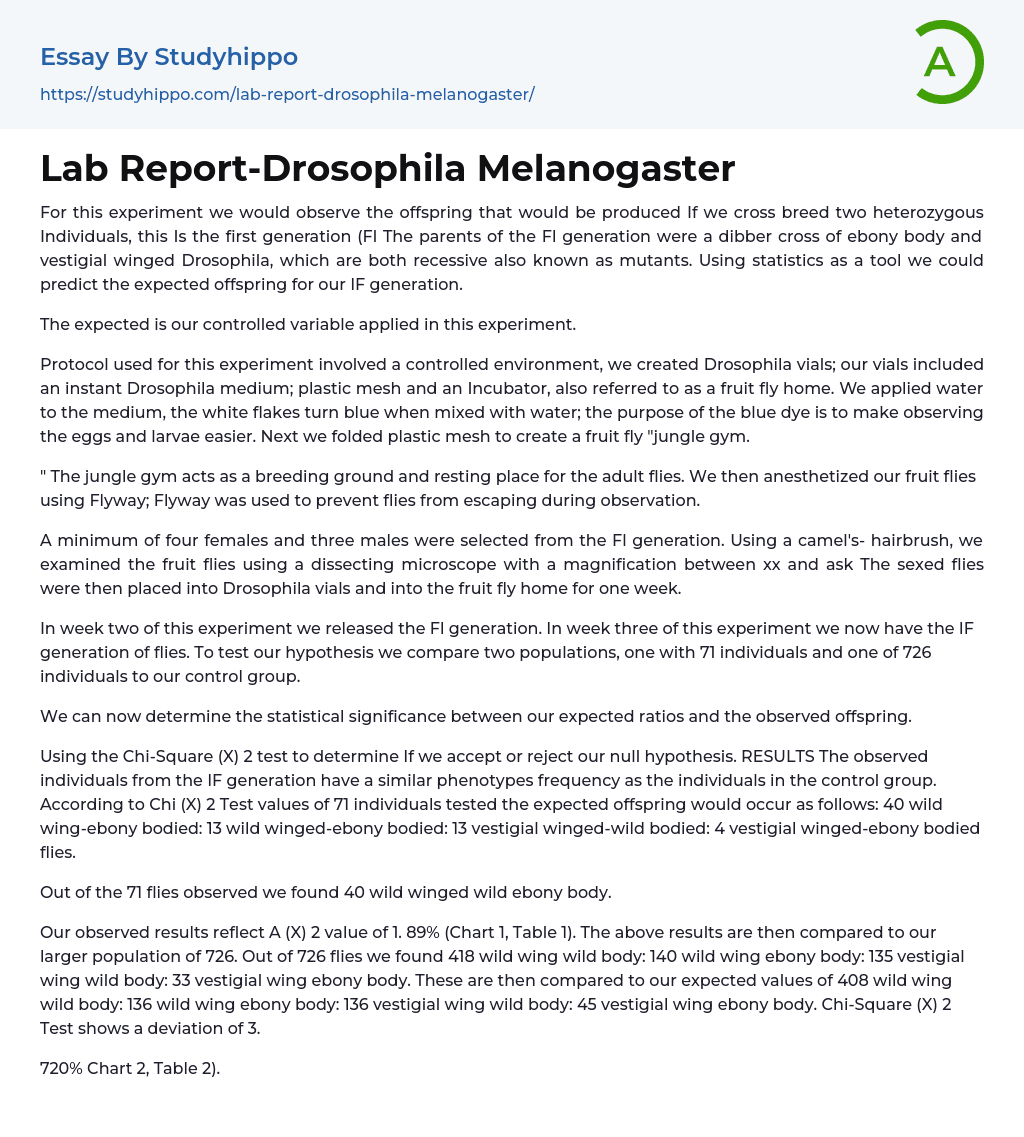For this experiment we would observe the offspring that would be produced If we cross breed two heterozygous Individuals, this Is the first generation (Fl The parents of the Fl generation were a dibber cross of ebony body and vestigial winged Drosophila, which are both recessive also known as mutants. Using statistics as a tool we could predict the expected offspring for our IF generation.
The expected is our controlled variable applied in this experiment.
Protocol used for this experiment involved a controlled environment, we created Drosophila vials; our vials included an instant Drosophila medium; plastic mesh and an Incubator, also referred to as a fruit fly home. We applied water to the medium, the white flakes turn blue when mixed with water; the purpose of the blue dye is to make ob
...serving the eggs and larvae easier. Next we folded plastic mesh to create a fruit fly "jungle gym.
" The jungle gym acts as a breeding ground and resting place for the adult flies. We then anesthetized our fruit flies using Flyway; Flyway was used to prevent flies from escaping during observation.
A minimum of four females and three males were selected from the Fl generation. Using a camel's- hairbrush, we examined the fruit flies using a dissecting microscope with a magnification between xx and ask The sexed flies were then placed into Drosophila vials and into the fruit fly home for one week.
In week two of this experiment we released the Fl generation. In week three of this experiment we now have the IF generation of flies. To test our hypothesis we compare two populations, one with 71 individuals and
one of 726 individuals to our control group.
We can now determine the statistical significance between our expected ratios and the observed offspring.
Using the Chi-Square (X) 2 test to determine If we accept or reject our null hypothesis. RESULTS The observed individuals from the IF generation have a similar phenotypes frequency as the individuals in the control group. According to Chi (X) 2 Test values of 71 individuals tested the expected offspring would occur as follows: 40 wild wing-ebony bodied: 13 wild winged-ebony bodied: 13 vestigial winged-wild bodied: 4 vestigial winged-ebony bodied flies.
Out of the 71 flies observed we found 40 wild winged wild ebony body.
Our observed results reflect A (X) 2 value of 1. 89% (Chart 1, Table 1). The above results are then compared to our larger population of 726. Out of 726 flies we found 418 wild wing wild body: 140 wild wing ebony body: 135 vestigial wing wild body: 33 vestigial wing ebony body. These are then compared to our expected values of 408 wild wing wild body: 136 wild wing ebony body: 136 vestigial wing wild body: 45 vestigial wing ebony body. Chi-Square (X) 2 Test shows a deviation of 3.
720% Chart 2, Table 2).
- Microbiology essays
- Bacteria essays
- Cell essays
- Enzyme essays
- Photosynthesis essays
- Plant essays
- Natural Selection essays
- Protein essays
- Viruses essays
- Cell Membrane essays
- Human essays
- Stem Cell essays
- Breeding essays
- Biotechnology essays
- Cystic Fibrosis essays
- Tree essays
- Seed essays
- Coronavirus essays
- Zika Virus essays
- Human Skin Color essays
- Digestive System essays
- Anatomy and Physiology essays
- Addiction essays
- Biodegradation essays
- Dental Care essays
- Disease essays
- Disorders essays
- Health Care essays
- Intelligence Quotient essays
- Nutrition essays
- Olfaction essays
- Public Health essays
- Women's Health essays
- World health organization essays
- Cancer essays
- Infectious Disease essays
- Lung Cancer essays
- Neurology essays
- Physical Exercise essays
- Medicine essays
- Sex essays
- Inquiry essays
- Disability essays
- Poison essays
- Action Potential essays
- Nervous System essays
- Childbirth essays
- Puberty essays
- Blood essays
- Kidney essays




